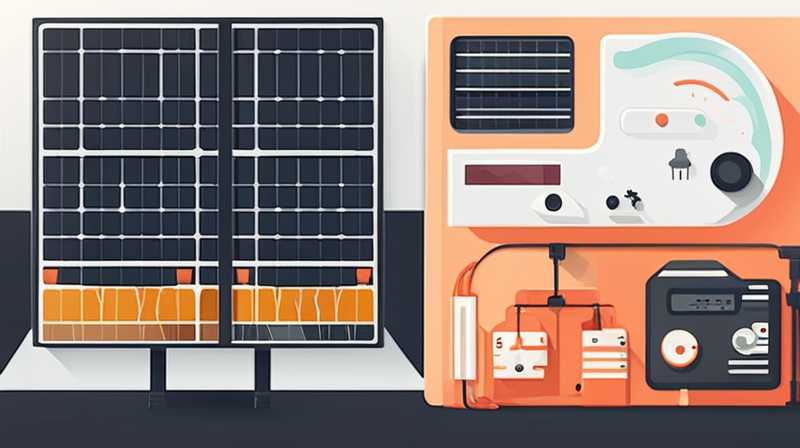
The longevity of old-fashioned solar power systems is influenced by several factors, including 1. Quality of Materials, 2. Maintenance Practices, 3. Technological Advancements, 4. Environmental Conditions. The lifespan of traditional solar panels—a critical component of these systems—often ranges from 25 to 30 years.
1. Quality of Materials
The durability of solar panels rests heavily on the quality of the materials used in their construction. Robust silicon-based cells, tempered glass, and resilient frames are essential for ensuring that the panels can withstand various environmental stressors. High-quality panels are designed to endure temperature fluctuations, moisture, hail, and other forms of physical impact. In contrast, inferior materials can lead to premature degradation, affecting energy production efficiency over time. Furthermore, reputable manufacturers often provide warranties lasting 20 to 25 years, reflecting their confidence in the product’s durability.
2. Maintenance Practices
Regular maintenance plays a pivotal role in extending the life of solar installations. Routine inspections can detect issues such as dirt accumulation, shading from nearby objects, or micro-cracks in the panels. Cleaning the surfaces to remove dirt and debris ensures that sunlight effectively reaches the solar cells, allowing for maximum energy output. Moreover, addressing electrical issues promptly can prevent more severe damages. Maintenance schedules and checks can often be negotiated with service providers to enhance the system’s longevity.
3. Technological Advancements
The solar energy sector has witnessed remarkable technological progress over the past few decades. Innovations in energy storage systems, control technology, and panel design continue to emerge. Older solar power systems equipped with outdated technology may not benefit from these advancements, potentially limiting efficiency and usability. In contrast, modern systems often incorporate smart technology that optimizes energy capture and storage, resulting in a more productive energy system overall. For consumers with older installations, retrofitting such systems with newer technologies may be a viable option to extend their functional lifespan.
4. Environmental Conditions
Environmental factors, such as humidity, temperature extremes, and geographical location, largely influence the longevity of solar installations. Areas prone to high humidity may accelerate corrosion, while regions with excessive sunlight may cause thermal issues. To maximize durability, solar panels should be specifically chosen for their compatibility with local weather conditions. For instance, products designed for coastal areas tend to employ materials resistant to salty air.
5. Financial Considerations
Investing in high-quality solar panels with extended warranties might involve higher upfront costs but can offer considerable long-term savings. Not only do reliable systems produce energy more effectively over time, but they also tend to require less frequent replacements which subsequently mitigates costs associated with reinstallation and disposal. Moreover, understanding the financial incentives provided by local governments can enhance the rationale for upgrading older systems.
6. End-of-Life Management
As solar technology continues to develop, addressing the disposal and recycling of old solar panels has become crucial. Many components of solar panels can be recycled, thus reducing environmental impact significantly. Manufacturers are increasingly exploring sustainable practices for panel disposal. Prioritizing environmentally friendly end-of-life strategies can facilitate the transition towards advanced solar technologies, improving overall sustainability
FAQs
HOW LONG DO SOLAR PANELS LAST?
Solar panels typically exhibit a lifespan of approximately 25 to 30 years, primarily dependent on the materials used in their construction, maintenance practices, and environmental exposure. Most manufacturers offer warranties that cover the performance of the panels for 20 to 25 years, assuring customers of their durability and sustained operational capability. It’s important to note that, while the panels themselves may still function beyond 30 years, their efficiency could decline. Many systems retain about 80% of their original efficiency after two decades, still allowing significant energy production for years beyond their expected lifespan.
HOW CAN YOU EXTEND THE LIFETIME OF SOLAR PANELS?
Extending the operational life of solar panels primarily revolves around proper maintenance and regular inspections. Routine upkeep—including cleaning the panels and ensuring they are free of debris—plays a crucial role in performance. Additionally, timely repairs of any evident damages or mechanical issues can prevent exacerbation over time. Educating oneself about environmental conditions can also aid in making informed decisions regarding the panel’s placement to avoid shading or overheating.
WHAT ARE THE SIGNS THAT SOLAR PANELS NEED TO BE REPLACED?
Indicators that solar panels may require replacement include a noticeable drop in energy production, physical damage such as cracks or delamination, and age exceeding 25 years. As panels age, their effectiveness diminishes, often producing 80% or less of their rated capacity. Furthermore, if maintenance costs begin to escalate significantly alongside a drop in performance, it may indicate the necessity for a new installation. By monitoring energy output and physical conditions closely, homeowners can better gauge the need for replacement.
As solar technology evolves, addressing how long traditional systems can last sheds light on the balance between benefit and sustainability. Many old-fashioned solar power systems, if maintained properly and situated in suitable environments, can perform efficiently for much longer than their initial projections. While their operational efficiency may decline with time, the potential for repair, along with financial savings from energy production, remains noteworthy. The consideration of technological upgrades, geographical conditions, and maintenance practices underscores the complexity of solar longevity.
Furthermore, making the transition to more advanced technologies can provide consumers substantial leverage in optimizing energy output and achieving sustainability goals. As the focus on renewable energy intensifies globally, understanding the longevity of older systems can pave the way for informed decisions in maximizing investments.
In a world predicated on energy consumption, old-fashioned solar power represents both a historical milestone and an ongoing commitment towards a more sustainable future. The journey from traditional inputs towards modern advancements continues to evolve, presenting ample opportunities for replacing, retrofitting, and optimizing solar energy solutions. Ultimately, strategic decisions grounded in knowledge and awareness will empower consumers to benefit from the longevity of their solar power systems, ensuring that the transition towards renewable energy is both profitable and sustainable.
Original article by NenPower, If reposted, please credit the source: https://nenpower.com/blog/how-long-can-old-fashioned-solar-power-last/


